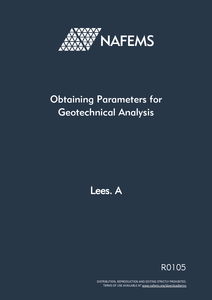
Increasingly powerful personal computers combined with user friendly numerical analysis software are giving rise to greater emphasis on numerical analysis in geotechnical design. For the ongoing transition from empirically to numerically based design to continue engineers will need to ensure appropriate parameters are adopted. However, obtaining appropriate parameters is not just a matter of getting results from standardised tests. There is an over-riding need to ensure that any set of parameters adopted adequately reflect complex field behaviour. If the soil parameters are not obtained to a sufficiently high degree of accuracy then the subsequent numerical analyses will be of little value and potentially lead to the wrong design decisions.The main objective of this book is to provide guidance on all stages of obtaining geotechnical parameters for numerical analysis, from selecting constitutive models,to planning and specifying the site investigation, interpreting data and deriving soil parameters, and assessing the reliability of soil parameters in a numerical model.
For specific discussions and worked examples, five common constitutive soil models are used throughout this book: linear elastic perfectly plastic model with Mohr-Coulomb failure criterion (M-C), Modified Cam Clay (MCC), Hardening soil model (HS), Hardening soil model with small-strain stiffness (HSsmall) and Jardine et al small strain model (JSS). However, the guidance provided in this book is still largely applicable to all constitutive soil models.
Target Audience
- This book is aimed at readers with various backgrounds. It can be used by experienced geotechnical analysts as a reference tool for obtaining and validating geotechnical parameters, but also by novice analysts in order to develop their competences in all aspects of obtaining geotechnical parameters.
- It can also be used by those involved in all stages of site investigations for numerical analysis, even if they have no involvement in numerical analyses themselves, since this book provides extensive guidance and references on advanced site investigation techniques and, furthermore, helps site investigation specialists to understand the needs of numerical analysts.
Content
| 1. Introduction |
| 2. Analysis planning |
| 2.1 Overview of soil models |
| 2.2 Some factors to consider |
| 2.3 Typical applications |
| 3. Soil sampling and groundwater measurement |
| 3.1 Soil sampling |
| 3.2 Groundwater monitoring |
| 3.3 Case studies |
| 4. Soil testing |
| 4.1 Test planning |
| 4.2 Laboratory testing |
| 4.3 In situ testing |
| 4.4 Case studies |
| 5. Parameter derivation and validation |
| 5.1 Parameter derivation |
| 5.2 Parameter validation |
| 5.3 Case studies |
| 6. Other sources of parameters |
| 6.1 When there is insufficient site investigation data |
| 6.2 Case studies |
| 7. Reliability of parameters |
| 7.1 Assessment of soil model accuracy |
| 7.2 Managing potential errors |
| 7.3 Case studies |
| 8. Standards |
| 9. References |



